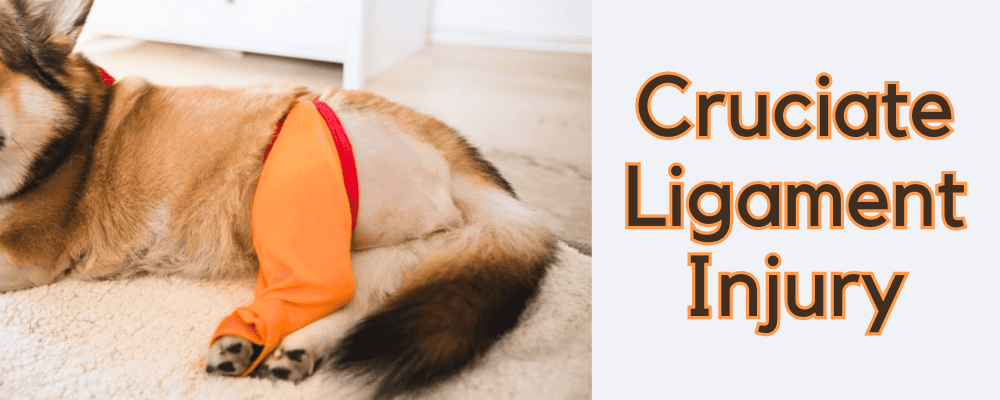The knee or stifle joint of the dog is one of the weakest in the body. Just as athletes (football players, in particular) frequently suffer knee injuries, the dog also can get knee injuries. The knee joint is relatively unstable because there is no interlocking of bones in the joint. Instead, the two main bones, the femur and tibia, are joined with four ligaments. The most common injury of the knee is a rupture of the cranial cruciate ligament (CCL – in humans it is called an anterior cruciate ligament or ACL). When the CCL is torn, instability occurs that allows the bones to move in an abnormal fashion in relation to one another, causing damage to the joint cartilage.
Causes
In younger dogs, rupture of the CCL is usually the result of trauma to the stifle joint. In some cases, the ligament may only partially tear; however, this will eventually lead to complete tearing of the ligament. When CCL rupture occurs in older dogs, it is most frequently initiated by a progressive degenerative change in the ligament with eventual total rupture. Therefore the dog does not have to do anything extraordinary to cause the tear. Often they are running in the back yard, plant the foot for a turn, and the ligament breaks.
Contributing Factors
A special note is appropriate concerning the dog’s weight. Obesity or excessive weight can be a strong contributing factor in cruciate rupture. The ligament may become weakened due to carrying too much weight; this causes it to tear easily. Obesity will make the recovery time much longer, and it will make the other knee very susceptible to cruciate rupture. If your dog has a weight problem, there are prescription diets that can be used to assist weight reduction. Make an appointment with one of our doctors to discuss a weight loss program.
Prevalence
Rupture of the CCL is most common in middle aged and older dogs, particularly those that are overweight house pets. It can also occur in cats, usually from trauma, but it is not as common.
Clinical Signs
Dogs with a ruptured CCL are usually lame and may refuse to bear weight on the affected leg. As the acute pain subsides, most dogs become more willing to bear weight but some degree of lameness remains.
Diagnosis
The most reliable for your veterinarian to diagnose this injury is to manipulate the femur and tibia in a certain way to demonstrate the instability. This movement is called a “drawer sign.” It can usually be demonstrated with the dog awake. If the dog is very painful, has very strong leg muscles, or is uncooperative, it may be necessary to use sedation in order to examine the joint adequately. Radiographs are usually not necessary for a diagnosis of CCL tear, as the ligament does not show up on x-ray, but radiographs are indicated to rule out other coexisting conditions.
Occasionally, the injury that causes a ruptured cranial cruciate ligament will also result in tearing of one of the menisci or “cartilages.” At the time of surgery, these are examined and torn portions are removed.
Treatment
Small dogs may get enough stability in the joint to avoid surgery, but in most cases, correction of CCL rupture is going to require a surgical repair. There are three primary ways to correct this problem.
Extracapsular Repair– After removing the damaged ligament, the surgeon can insert a replacement ligament and stabilize the joint so it functions normally or near normally. This synthetic ligament or suture is placed outside the joint capsule.
Tibial Tuberosity Advancement (TTA)– In this procedure, the insertion of the patellar tendon (called the tibial tuberosity) is advanced forward to take the shear forces out of the joint. Once that is done, there is no need for the cruciate ligament any more. This procedure is favored in larger, younger and more active dogs because of the chance that the artificial ligament could break.
Tibial Plateau Leveling Osteotomy (TPLO)– This is similar to the TTA, except the top of the tibial (tibial plateau) is rotated to remove the shear forces.
Prognosis
Occasionally, small dogs that have a ruptured cruciate ligament will become sound (will no longer limp), even if surgery is not performed. However, in dogs over 30 pounds, progressive, degenerative arthritis will usually develop without surgery. Once these degenerative changes are established, the lameness cannot be corrected, even with surgery.
Following proper and prompt surgical correction, the joint is sound again in 85% of the cases. Most dogs walk and run without any lameness; however, some have either a mild limp or lameness associated with cold and damp weather. If your dog should ever develop a sudden lameness, please make an appointment for an exam so that we can determine the cause and recommend the best course of action to take.
